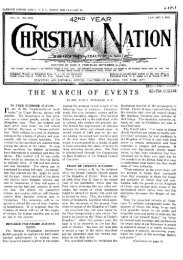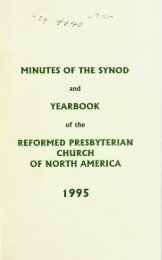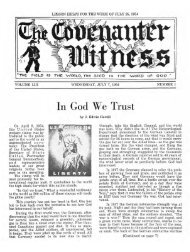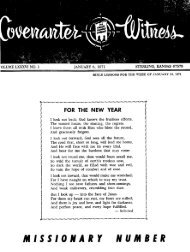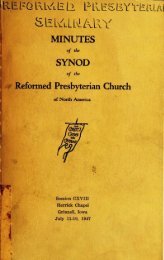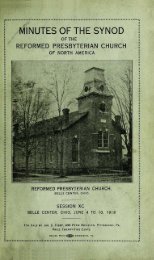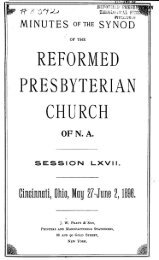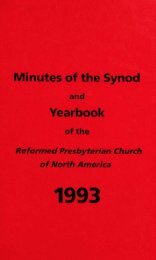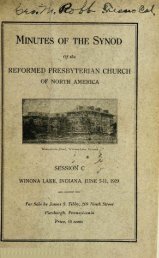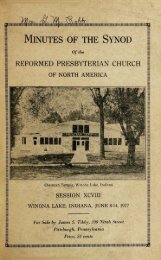Covenanter Witness Vol. 55 - Rparchives.org
Covenanter Witness Vol. 55 - Rparchives.org
Covenanter Witness Vol. 55 - Rparchives.org
Create successful ePaper yourself
Turn your PDF publications into a flip-book with our unique Google optimized e-Paper software.
wheel"rodders."rod"What Teen-Agers Are Doing for Traffic SafetybyM. R. Darlington, Jr., Managing Director, Inter-Industry Highway Safety CommitteeThe strength of youth, quick reflexes, and agreat capacity for developing skills make teen-agerspotentially America's best drivers. But, because ofthe irresponsible antics of a minority of their generation, young drivers as a group are described insuch incriminating phrases as "kid killers at theand "wild hotThroughout the nation, responsible groups ofteen-agers, tired of being tagged with such generalizations, are taking positive action to improvetheir reputations and, at the same time to demonsafe drivers.strate that they are, for the most part,Dramatic evidence of the teen-agers' intent isfound in the more than 100 traffic safety conferences which the youngsters have sponsored in 23states and the District of Columbia. Planned andrun by the teen-agers themselves with a minimumof guidance or direction from adults, the conferenceshave produced many worthwhile and level-headedrecommendations. These include suggestions for highschool driver education for all potential young drivers, stricter law enforcement for all drivers, morerigid licensing laws, and equal treatment for teenagers and adults.A recent study of driver education shows approximately half of the nation's public schools nowoffer either classroom instruction, practice driving,or both. While only about 29 per cent of the eligiblestudents received a complete course last year, moreand more schools are expanding their programs toinclude both classroom and practice driving instruction.Results show driver education to be one of themost effective traffic safety tools. In many states,reviews of the records of graduates of accrediteddriver education courses have disclosed that trainedyoung drivers have had approximately 50 per centfewer accidents and traffic violations than untraineddrivers in the same age group. In Minnesota, a fiveyearstudy by the State Department of Educationrevealed that 34.3 per cent of the untrained driversstudied were involved in reported accidents asagainst only 18.7 per cent of the drivers who had received a complete course including both classroomand practice driving instruction.The teen-age conferences, many of which arenow held annually, have done much more than simplypass recommendations. In several states permanent<strong>org</strong>anizations have been set up to put conferenceideas into action, and, in many places, teen-age traffic safety clubs have been formed to carry out localprograms. For example:Cleveland's Youth Traffic Council conducts vehicle safety-checks to be sure the cars students driveto school are in safe operating condition.In Palo Alto, California, the Paly Stompers Clubis making plans for its second safety-economy runan event placing emphasis on safe, courteous, econo422to, "Stomp Out Bad Driving," require members tomaintain violation free driving records.In Beaverton, Oregon, Judge Frances Cook hasgiven her support to young drivers by helping them<strong>org</strong>anize "Safe-Teen" Clubs. Members display a redmical driving. The boys, who have adopted the mot-and black bumper strip which identifies the vehicleas being driven by a "Safe-Teen."Furthermore,safety-teen-agers must have the car they drivechecked and must drive without violations.In Norfolk, Virginia, a high school group produced its own movie to point out some of the city'smore dangerous intersections and pedestrian crossings.In Iowa, a "hot club is helping remove thestigma many persons attach to those words by helping motorists who have tire or mechanical difficulty.The boys give persons they help a card which asserts : "Dedicated to safety. You have received assistance through the courtesy of the Knights of theRoad Hot Rod Club."In Ferndale, Michigan, the Teen-Age MechanicsClub teaches members to repair and improve theircars and, importantly, to keep them safe. Guided byan automobile salesman and a car dealer, membersof the Teen-Age Mechanics Club meet weekly towork on their cars. Club members also make a practice of extending aid to motorists in distress. Theirfree help is explained by a card which reads, "Weenjoy extending this courtesy to you as membersof the Teen-Age Mechanics Club." Enthusiastic supporters of the Club are the boys' mothers, one ofwhom is reported to have said: "I would rathersee my boy come home covered with grease thanwith blood."National traffic safety <strong>org</strong>anizations are encouraging and helping the teen-age safety movement.For example, the Inter-Industry Highway SafetyCommittee has worked with teen-agers in many oftheir traffic safety conferences. Recently the Committee began publishing a bulletin devoted directly tothe traffic safety activities of the nation's youngdrivers. For several years the Committee has encouraged complete courses in driver education inhigh schoolsThe National Safety Council has developed akit of suggestions and materials which studentcouncils and other groups can use in planning trafficsafety projects. Insurance groups maintain an activeinterest in young drivers and several companies havereduced insurance rates to those who have had acomplete course in driver education.The realistic attitude of America's teen-agerstoward traffic safety is of vital importance to everyone. It is an attitude which should be aided and encouraged. Each year in the United States, two millionyoungsters reach driving age, and the vast majoritysooner or later will take their places behind thewheel. But less than 30 per cent have completedhigh school driver education courses available to(Continued on page 423)COVENANTER WITNESS



